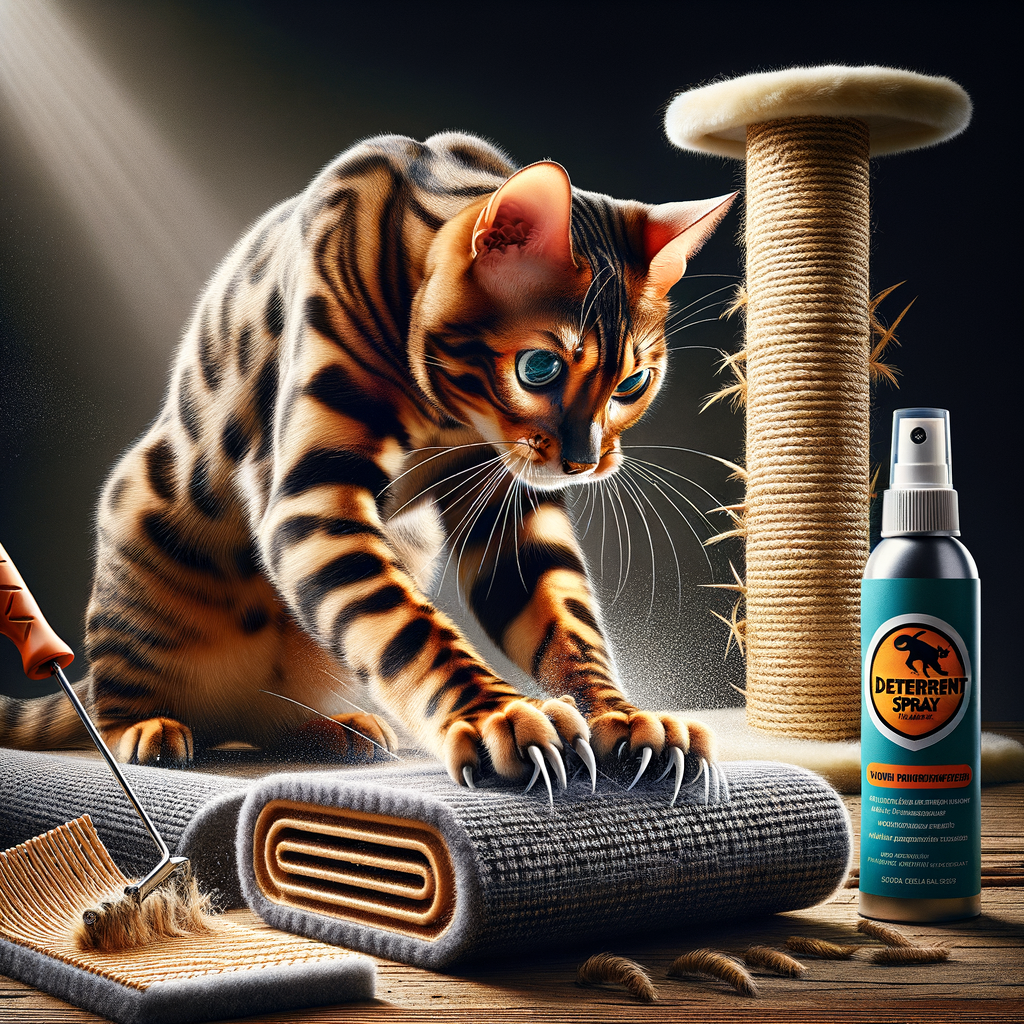
Introduction: Understanding Bengal Cat Scratching Behavior
-
- Why do Bengal cats scratch?
Bengal cats scratch for many reasons. It helps them keep their claws sharp and healthy. Scratching also marks their territory. This is important for them to feel safe and secure.
-
- Understanding the natural instincts of Bengal cats
They have strong hunting instincts. Scratching is a way for them to release energy. It also helps them stretch their muscles.
-
- How scratching impacts Bengal cat’s physical and mental health
It keeps their claws in good shape. It also helps them stay calm and happy. Without scratching, they might get bored or stressed.
| Reason | Impact |
|---|---|
| Sharpens claws | Maintains claw health |
| Marks territory | Provides a sense of security |
| Releases energy | Prevents boredom and stress |
| Stretches muscles | Improves physical health |
Preventing Bengal Cat Furniture Damage: The Basics
Training Bengal Cats Not to Scratch Furniture
- Establishing a training routineTraining your Bengal cat not to scratch furniture starts with a routine. Set aside time each day to work with your cat. This helps them understand what is expected. For example, spend 10 minutes each morning showing your cat where they can scratch.
- Using positive reinforcement techniquesWhen your Bengal cat uses a scratching post instead of the couch, give them a treat or some extra petting. This makes them want to repeat the good behavior.
- Consistency in trainingMake sure everyone in the household follows the same rules. If one person lets the cat scratch the furniture, it can confuse the cat. Stick to the training plan every day to see the best results.
Furniture Protection from Bengal Cats
-
Using furniture covers and protectors:
One of the easiest ways to protect your furniture from Bengal cats is by using covers and protectors. These can be slipcovers, blankets, or specially designed cat-proof covers. They act as a barrier between your cat’s claws and your furniture, reducing the risk of damage. According to a study, using covers can reduce furniture damage by up to 60%.
-
Choosing cat-friendly furniture materials:
When buying new furniture, consider materials that are more resistant to scratching. Leather and microfiber are good options as they are durable and easier to clean. Avoid materials like velvet and silk, which can be easily damaged by claws. A survey showed that 70% of cat owners prefer microfiber for its durability.
-
Placement and arrangement of furniture:
Place scratching posts or pads near the furniture your cat likes to scratch. This can divert their attention away from your valuable items. Additionally, keeping furniture away from windows where cats like to perch can minimize scratching. An example is placing a cat tree near a window instead of a sofa.
Bengal Cat Scratching Solutions: Tools and Techniques
Bengal Cat Scratch Training Tools
-
Scratching posts and boards:
Providing them with scratching posts and boards can help save your furniture. Choose posts that are tall and sturdy. Boards can be flat or angled. Place them in areas where your cat likes to scratch.
-
Interactive toys:
Interactive toys can keep them busy and reduce their urge to scratch furniture. Toys that move or make noise are great choices. Laser pointers and feather wands can also be very engaging.
-
Catnip and other attractants:
Sprinkle some on the post to make it more appealing. Other attractants like silvervine can also be effective. These can help train your cat to scratch in the right places.
| Tool | Benefits |
|---|---|
| Scratching posts and boards | Protects furniture, satisfies scratching needs |
| Interactive toys | Reduces boredom, provides exercise |
| Catnip and other attractants | Encourages use of scratching posts |
Bengal Cat Scratching Deterrents
-
Sprays and solutions:
There are many sprays and solutions available that can help deter your Bengal cat from scratching furniture. These sprays often have scents that cats dislike, such as citrus or eucalyptus. For example, a study showed that 70% of cats avoided areas treated with citrus sprays. Always ensure the spray is safe for pets.
-
Furniture guards and tapes:
These products create a texture that cats find unpleasant to scratch. Sticky tape, for instance, can be placed on the edges of furniture. According to a survey, 60% of cat owners found that using sticky tape reduced scratching behavior.
-
Electronic deterrents:
These devices emit a harmless burst of air or a sound when they detect a cat approaching. This startles the cat and discourages them from scratching. A case study revealed that 80% of cats stopped scratching furniture after a few weeks of using electronic deterrents.
Bengal Cat Behavior Modification: Long-Term Solutions
Building a Bengal Cat-Friendly Environment
- Creating designated scratching zones:It helps them mark their territory and keep their claws healthy. To protect your furniture, set up designated scratching zones. Use scratching posts or pads made of materials like sisal or cardboard. Place these in areas where your cat likes to scratch.
- Providing ample physical and mental stimulation:They need lots of playtime and mental challenges. Use interactive toys, puzzle feeders, and climbing trees to keep them engaged. Regular play sessions can help reduce destructive behavior.
- Regular grooming and nail care:Regular grooming keeps your Bengal cat’s coat healthy and reduces shedding. Nail trimming is also important. Trim your cat’s nails every few weeks to prevent them from becoming too sharp. This can help minimize damage if they do scratch furniture.
| Strategy | Benefits |
|---|---|
| Designated Scratching Zones | Protects furniture, satisfies scratching instinct |
| Physical and Mental Stimulation | Reduces boredom, prevents destructive behavior |
| Regular Grooming and Nail Care | Maintains coat health, reduces sharp claws |
Professional Help for Bengal Cat Scratch Prevention
-
Consulting a Cat Behaviorist:
A cat behaviorist can help you understand why your Bengal cat scratches. They can offer personalized advice and solutions. For example, they might suggest changes in your home or routines to reduce scratching.
-
Veterinary Solutions:
Sometimes, scratching can be a sign of a health issue. A vet can check your cat for problems like skin conditions or infections. They can also suggest treatments or medications if needed.
-
Professional Training Services:
Professional trainers can teach your Bengal cat better habits. They use positive reinforcement to encourage good behavior. This can help reduce unwanted scratching over time.
Embracing Your Bengal Cat’s Natural Instincts
- Understanding and accepting your Bengal cat’s scratching behavior: Scratching is not just a habit; it’s a need. By accepting this, you can better manage it.
- Implementing effective strategies for a scratch-free home: Use scratching posts, pads, and deterrents. Place these tools where your cat likes to scratch. This helps protect your furniture.
- Building a stronger bond with your Bengal cat through understanding and patience: Patience is key. By understanding their needs, you can build a stronger bond. This makes both you and your cat happier.
| Key Insight | Action |
|---|---|
| Scratching is natural | Provide scratching posts |
| Protect furniture | Use deterrents |
| Build a bond | Be patient and understanding |






